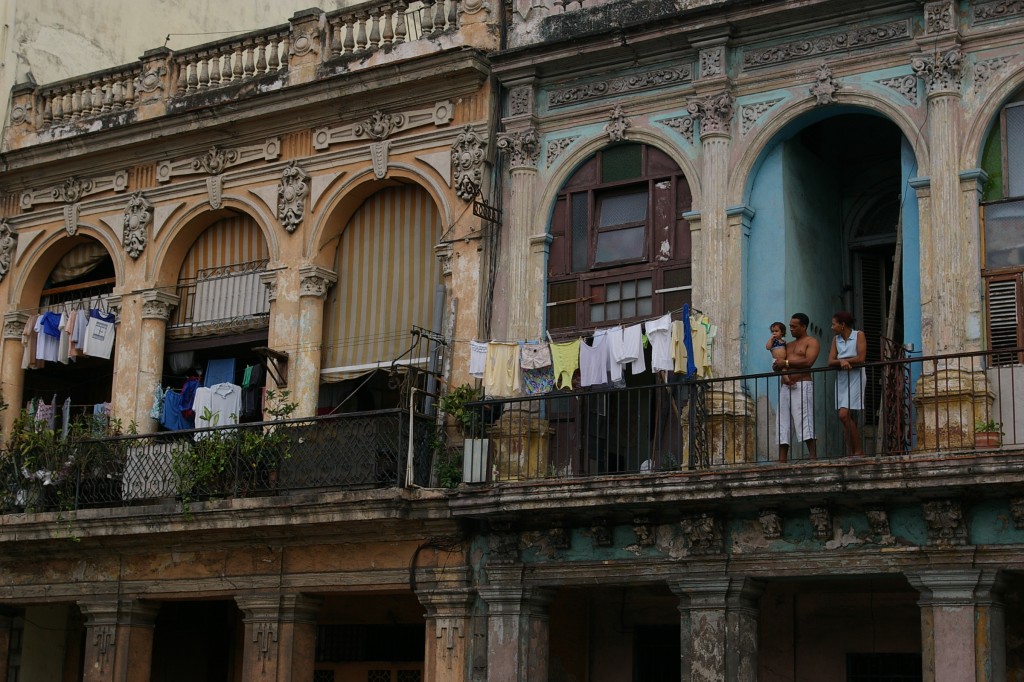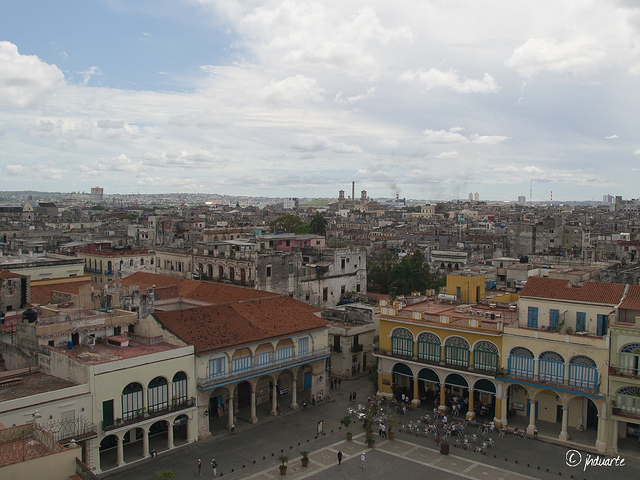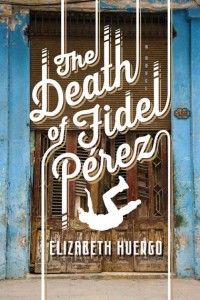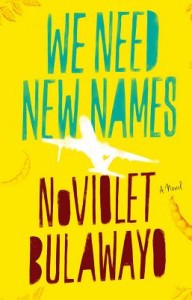 Is fiction always political? Elizabeth Huergo thinks so. In her debut novel, The Death of Fidel Pérez, when the title character and his brother comically fall from their Havana balcony to their deaths, a rumor that “Fidel has fallen” awakens the city. Their fictional fall coincides with the 50th anniversary of the Moncada Army Barracks raid that sparked the Cuban Revolution. The news of the death revives hope for political change and stirs the unrealized promises of the past. In this provocative novel, fiction and history, prose and politics collide.
Is fiction always political? Elizabeth Huergo thinks so. In her debut novel, The Death of Fidel Pérez, when the title character and his brother comically fall from their Havana balcony to their deaths, a rumor that “Fidel has fallen” awakens the city. Their fictional fall coincides with the 50th anniversary of the Moncada Army Barracks raid that sparked the Cuban Revolution. The news of the death revives hope for political change and stirs the unrealized promises of the past. In this provocative novel, fiction and history, prose and politics collide.
Elizabeth Huergo was born in Havana and immigrated to the United States at a young age as a political refugee. She teaches at George Mason University and lives in Virginia. The Death of Fidel Pérez, published by Unbridled Books, is her first novel.
We met at Teaism in Washington, D.C.’s Penn Quarter and discussed the perils of trying to micromanage the universe over plentiful cups of lavender tea.
Interview
Melissa Scholes Young: You and I are both from iconic places, and those places are forces in our writing. I grew up on the banks of the Mississippi in Hannibal, Missouri—Mark Twain’s boyhood home. In The Death of Fidel Pérez, Havana is a central character in this story. How does place define you as a person and as an author?
Elizabeth Huergo: Place is a character in this novel; but character is inextricable from place. Nadine Gordimer in Burger’s Daughter, which is very much about exile, quotes Claude Levi-Strauss: “I am the place in which something has occurred.” There’s a sense in which I am the city and I am the history. By that I mean my whole life has been shaped by my exile and by the absence from that place. My life has been defined by a series of events that were never under my direct control. That’s one of the reasons I always talk about the blunt-force trauma of history. This city has lived in the memory of my parents, and the experience and history of it has been transferred to me as a collection of stories, anecdotes, until it is a character, like a family member.
How long did it take to write this story?
It took me eight years because I wasn’t just writing. I was teaching myself to write a novel. It’s also a very elegiac story. My own relationship to the manuscript was an emotional sorting through of where I came from, of my parents’ dreams and of my own dreams. I was recreating something that I had lost, but also something that I was finding through the process of storytelling. I had to go through my parent’s story to find my own. So in that sense, it was a coming to terms with this place that I had lost. It wasn’t just the writing. The writing process was an emotional journey.
I read that the vision of your character Saturnina in her rocking chair at the top of the staircase in a crumbling building was a haunting image from your own travels. During the eight years of writing, did you return to Cuba?
I went to Cuba, and when I returned to the U.S. I began this novel. The visit propelled the book, but I wasn’t able to return at any time during the process. Nothing I expected happened in the writing. In her stories about Remedios, Cuba, where she grew up, my mother sometimes talks about Saturnina, a crazy woman who decided one day to put on all of her skirts and live in the streets.
When I returned to Cuba as an adult to see my family, I walked all over Havana with my cousins. One day, as we were walking through La Habana Vieja [Old Havana], I peered into a building covered by mosaic tiles, indigo arabesques against a creamy white field, miraculously intact, that pointed back to the island’s history as a Spanish colony and even further back to the Arab culture that taught medieval Spaniards how to draw curves, how to make arches, how to rethink the beauty and function of an interior garden.
 I didn’t realize, however, that on the other side of the tiled façade, most of the building was gone. I peered inside and found, at the top of a barely intact stairwell, an old woman in a rocking chair, the morning sky behind her, wearing everything she owned, and for all the world appearing to me as an ancient Madonna in a grotto. A terrible wave of shame overcame me. I was expecting to see a grand foyer, one more example of the island’s rich architectural history that I could photograph. Instead, I felt like the nosiest of neighbors, skulking about and intruding on her privacy and taking away her dignity.
I didn’t realize, however, that on the other side of the tiled façade, most of the building was gone. I peered inside and found, at the top of a barely intact stairwell, an old woman in a rocking chair, the morning sky behind her, wearing everything she owned, and for all the world appearing to me as an ancient Madonna in a grotto. A terrible wave of shame overcame me. I was expecting to see a grand foyer, one more example of the island’s rich architectural history that I could photograph. Instead, I felt like the nosiest of neighbors, skulking about and intruding on her privacy and taking away her dignity.
I let go of the camera hanging around my neck. I wanted to apologize. There was nothing for me to say. She nodded, a monarch on her throne. I named her Saturnina, and she haunted me all the way back to the United States until I wrote down what had happened, first as a journal entry, and then eventually as the first chapter of The Death of Fidel Pérez.
You tell the story from three different points of view. Each is affected by the news of Fidel’s death differently. We have Saturnina, of course, and then Pedro Valle, a professor struggling with regret and grief, and Camilo, Pedro’s impressionable young student. How did each character’s perspective come into focus?
It’s difficult to suspend judgment during the writing process. As writers we have to learn to be nicer to ourselves. We have to let ourselves make mistakes. I actually wrote each point of view separately. I was about halfway through each character’s entire story when I realized how they fit together. Then it was like shuffling a deck of cards to layer their point of views into a cohesive story. I had to learn what is a scene. I had to figure out how one action can create the tension that will propel it forward into the next scene. The story isn’t really plot driven, so the characters and their points of view have to hold the whole together.
The Death of Fidel Perez is told in one day. From the balcony scene in the morning to the protest in the evening all of the action happens in the same space of time. What led to that decision?
I had James Joyce’s Ullyses in mind. I wanted to be precise, so I found the day on the international calendar, and I went back to see when the sun rose and set on that day.
I took out a map of Havana and tracked each character’s journey. I also measured to make sure that it would be possible for someone to walk that distance in the amount of time I was giving them.
 We get this hilariously tragic scene at the opening. Fidel, in a drunken stupor, and his brother, Rafael, accidentally tumble over their own balcony. Then there is the case of mistaken identity and contagious rumor that “Fidel calló!” It propels the narrative. Did you write this scene first?
We get this hilariously tragic scene at the opening. Fidel, in a drunken stupor, and his brother, Rafael, accidentally tumble over their own balcony. Then there is the case of mistaken identity and contagious rumor that “Fidel calló!” It propels the narrative. Did you write this scene first?
It took an outside lens to see the structure of this novel. Do you know Richard Peabody? He’s an extraordinary teacher and mentor. He teaches in the MFA program at Johns Hopkins University, and he’s the midwife to so many different writers. When he read an earlier version of the manuscript, he said chapter five, the balcony scene, had to be the beginning. Originally Pedro waking up was the beginning, but it didn’t resonate as well as the Fidel brothers’ scene. I knew better than to ignore his advice.
How did you decide about the rest of the structure?
I have a moment in my mind when I see the entire novel. In a flash the story becomes a beautiful architectural space that I can move through. I see this space in my mind’s eye, but I can also sense my movement through it. The flash is both a blessing and a curse because I end up pursuing this vision in a very Romantic or Shelleyan sense.
Let’s talk about the power of water. Water seems both a threat and a savior throughout the novel. Camilo, Pedro, Mario, Camilo’s mother—they’re all attracted to and frightened by water. Water is also used as a metaphor for emotion. At one point you describe a “wave of guilt…its crest broke over his heart.” The rumor of Fidel’s death also travels like water. That water is uncontrollable and has a life of its own. It can do terrible damage, too.
Water in also symbolic of the great Unconscious, and since my novel explores the idea of revolution as a shift in consciousness, the Cubans who descend into the street on that 50th anniversary of the Moncada Army Barracks raid are a river—ubiquitous, protean, and overwhelming in its power to transform the banks that are on either side of it. There’s a Chinese proverb that goes something like this: Everyone sees the violence of the swollen river; few see the violence of the embankments that constrain it.
That’s so true. Water is a life-giving force but it can be destructive, too.
The passages you cite that refer to emotional states are moments in which characters are struggling to come to terms with unconscious or barely conscious parts of themselves. Rumor, language can also have that protean, all-encompassing power to shape how we see ourselves and the world around us. That power can be a positive force for good, but it can also become terribly negative and make concrete our unjust and destructive ideas about others. That’s how bigotry and xenophobia work—through a language that dehumanizes others.
Virginia Woolf’s presence is also in here. Saturnina, in her moment of anguish, stands at the water and wonders what it would be like to just walk in—the relief from pain, the choosing of one’s death rather than waiting for its arrival.
You and I share a passion for Virginia Woolf’s writing, and you are right to note that she has been an enormous influence on me on as a writer. She was an iconoclast, and there is no simple way to classify her writing. She gives a nod to the boundaries between prose and poetry, and then she ignores those very boundaries, and she does so brilliantly. Her work is so much about the fluidity and essential mystery of our lives, and her writing evokes and represents those qualities.
 And part of that mystery is self-determination, yes?
And part of that mystery is self-determination, yes?
Yes, self-determination is a very important idea in the novel, as it is in the history of responses to colonialism. To me self-determination isn’t just a political concept that refuses the second-class status of “the native,” but a requisite element of agency, the ability of each individual to act ethically in the world.
Pedro seems to struggle similarly to be self-determining. He wants to choose a path forward but he’s haunted by his history and the broken promises of the Cuban Revolution. He survives, yet he can’t forgive himself for betraying his best friend, Mario. Isn’t that a form of self-exile?
There is a separation in Pedro. He is exiled from himself. I want him to represent the tension between the historical and the lived experience—what history is before it’s codified into a cultural narrative.
There is a fine line between the living and the dead throughout this novel. The spirits, like Mario and Tomas, play an active role. Pedro is guided by Mario’s beliefs. Out of a mother’s grief and madness, Saturnina waits for Tomas’s salvation. How do the dead help the living survive?
When you live in a nation that has been politically destabilized by outside forces, anything is possible. I know what it’s like firsthand for a government to fall, for a system to collapse. If you’ve lived in a society where that has happened, there is nothing “magical” about that “realism.” I don’t think most people in the U.S. really understand that type of instability.
In his Nobel prize lecture, Gabriel García Marquez—sometimes dismissed for his “magical realism”—contested the European reading of Latin-American history, political and aesthetic. His point was that while we’re all living in the same moment of time, we’re not all living in the same moment of history.
I remember many years ago meeting a Holocaust writer and becoming friends with him. And one day I saw a number tattooed on his wrist, the number he had been given in a Nazi concentration camp. There was something about the idea that history had marked his body and given him this alternative identity. It felt like my own experience as a political refugee—though on a very different scale, of course.
I started reading Holocaust literature, especially Primo Levi, who struggled with his guilt at having survived. His sense of guilt exiled him, as did his inability to represent adequately what had happened. He had an extraordinary sense of duty and responsibility to those who never left the camps, who died there. I feel I have an obligation to represent, to tell a story about empire that I think it’s safe to say most people in the U.S. don’t know.
What are you working on now?
My second novel is called Between Anna and Ella. It’s about two Latina women who come from different backgrounds. Anna is a psychiatrist. Ella is a lawyer. The story is about their interactions in this analytic space and the trauma that Ella experiences defending an “illegal” immigrant.
The question that’s not asked is usually about Cuban history. Everyone knows about Fidel, but most people in the U.S. aren’t as familiar with Batista. Some readers have commented on the historical details, assuming those details are all imaginary. I have readers who think it’s a mystery. We’re always trapped by history and our interpretations of events, but I think we have to be honest about which histories we tell.
For Aristotle, plot is moral. Where you take a reader via a plot line carries with it an ethical responsibility. As writers, we have to be conscious where we take the reader. We have to make sure our plot trajectories have a value. The world is brutal and violent, and when we take our readers through a series of brutal and violent moments, we have a responsibility to stay conscious of meaning and purpose.
Links & Resources
Keep with Elizabeth Huergo’s news and events at her website.






